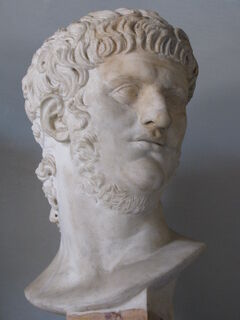Nero is a medical company that is Leland Schiller's main target of vengeance after the support for his mother was denied. Leland planned to unleash a cyber attack on one of the buildings.
Appearances[]
Trivia[]

Bust of Nero at the Musei Capitolini, Rome
Nero (/ˈnɪəroʊ/; Latin: Nerō Claudius Caesar Augustus Germanicus;[1] 15 December 37 – 9 June 68)[2] was Roman Emperor from 54 to 68, and the last in the Julio-Claudian dynasty. Nero was adopted by his grand-uncle Claudius to become his heir and successor, and succeeded to the throne in 54 following Claudius' death.
Nero focused much of his attention on diplomacy, trade and enhancing the cultural life of the Empire. He ordered theatres built and promoted athletic games. During his reign, the redoubtable general Corbulo conducted a successful war and negotiated peace with the Parthian Empire. His general Suetonius Paulinus crushed a revolt in Britain. Nero annexed the Bosporan Kingdom to the Empire and began the First Roman–Jewish War.
In 64 AD, most of Rome was destroyed in the Great Fire of Rome, which many Romans believed Nero himself had started in order to clear land for his planned palatial complex, the Domus Aurea. In 68, the rebellion of Vindex in Gaul and later the acclamation of Galba in Hispania drove Nero from the throne. Facing a false report of being denounced as a public enemy who was to be executed, he committed suicide on 9 June 68 (the first Roman emperor to do so).[3] His death ended the Julio-Claudian Dynasty, sparking a brief period of civil wars known as the Year of the Four Emperors. Nero's rule is often associated with tyranny and extravagance.[4] He is known for many executions, including that of his mother,[5] and the probable murder by poison of his stepbrother Britannicus.
He is infamously known as the Emperor who "fiddled while Rome burned".[6]; For a detailed explanation of this transition see M. F. Gyles "Nero Fiddled while Rome Burned", The Classical Journal 42, no. 4 (January 1947), pp. 211–17 – nevertheless, the idea that Nero played any kind of musical instrument is an urban legend, since he was away from Rome at the time of the fire.</ref> He was rumored to have had captured Christians dipped in oil and set on fire in his garden at night as a source of light.[7] This view is based on the writings of Tacitus, Suetonius and Cassius Dio, the main surviving sources for Nero's reign, but a few surviving sources paint Nero in a more favourable light.[8] Some sources, including some mentioned above, portray him as an emperor who was popular with the common Roman people, especially in the East.[9] Some modern historians question the reliability of ancient sources when reporting on Nero's tyrannical acts.[10]
References[]
- ↑ Classical Latin spelling and reconstructed Classical Latin pronunciation of the names of Nero:
- LVCIVS DOMITIVS AHENOBARBVS
IPA: ['luː.ki.ʊs dɔ'mɪ.ti.ʊs a.eː.nɔ'bar.bʊs] - NERO CLAVDIVS CAESAR AVGVSTVS GERMANICVS
IPA: ['nɛ.roː 'klau̯.di.ʊs ˈkae̯.sar au̯ˈgʊs.tʊs gɛr'maː.nɪ.kʊs]
- LVCIVS DOMITIVS AHENOBARBVS
- ↑ Nero's birth day is listed in Suetonius, The Lives of Twelve Caesars, Life of Nero 6. His death day is uncertain, though, perhaps because Galba was declared emperor before Nero died. The date of 9 June is calculated from Jerome, Chronicle, which lists Nero's rule as 13 years, 7 months and 28 days. Cassius Dio, Roman History LXII.3 and Josephus, War of the Jews IV, say Nero's rule was 13 years, 8 months which would be until 11 June.
- ↑ Suetonius states that Nero committed suicide in Suetonius, The Lives of Twelve Caesars, Life of Nero 49; Sulpicius Severus, who possibly used Tacitus' lost fragments as a source, reports that it was uncertain whether Nero committed suicide, Sulpicius Severus, Chronica II.29, also see T.D. Barnes, "The Fragments of Tacitus' Histories", Classical Philology (1977), p. 228.
- ↑ Galba criticized Nero's luxuria, both his public and private excessive spending, during rebellion, Tacitus, Annals I.16; Kragelund, Patrick, "Nero's Luxuria, in Tacitus and in the Octavia", The Classical Quarterly, 2000, pp. 494–515.
- ↑ References to Nero's matricide appear in the Sibylline Oracles 5.490–520, Geoffrey Chaucer's Canterbury Tales The Monk's Tale and William Shakespeare's Hamlet 3.ii.
- ↑ Nero was not a fiddle player, but a lyre player (the fiddle was not invented for at least another 1,500 years). Suetonius states Nero played the lyre while Rome burned, see Suetonius, The Lives of Twelve Caesars, Life of Nero
- ↑ Tacitus Annals XV.44.
- ↑ These include Lucan's Civil War, Seneca the Younger's On Mercy and Dio Chrysostom's Discourses along with various Roman coins and inscriptions.
- ↑ Tacitus, Histories I.4, I.5, I.13, II.8; Suetonius, The Lives of Twelve Caesars, Life of Nero 57, Life of Otho 7, Life of Vitellius 11; Philostratus II, The Life of Apollonius 5.41; Dio Chrysostom, Discourse XXI, On Beauty.
- ↑ On fire and Christian persecution, see F.W. Clayton, "Tacitus and Christian Persecution", The Classical Quarterly, pp. 81–85; B.W. Henderson, Life and Principate of the Emperor Nero, p. 437; On general bias against Nero, see Edward Champlin, Nero, Cambridge, MA: Harvard University Press, 2003, pp. 36–52 (ISBN 0-674-01192-9)
